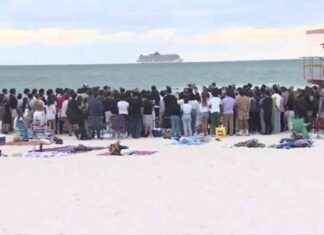SEOUL, South Korea aEUR “North Korea tested a barrage short-range missiles fired from multiple locations towards the sea on Sunday,” South Korea’s military reported. This was a provocative streak of weapons demonstrations this year, which U.S. officials and South Korean officials fear could culminate in a nuclear bomb explosion.
Eight missiles were fired simultaneously over 35 minutes, possibly setting a new record for North Korean ballistic launch records. They were fired from at least four locations, including the eastern and western coasts, and two inland areas near Pyongyang.
According to the report, the missiles flew between 110 and 670 kilometers (68-416,000 miles) at maximum altitudes 25 to 80 kilometers (15–56 miles), while traveling speeds of Mach 3 through 6.
General Won In-Choul, chairman of the South Korean Joint Chiefs of Staff, held a videoconference about the launches with Gen. Paul LaCamera (an American general who heads South Korea’s combined forces command in Seoul) and they reaffirmed their joint defense posture, according to the JCS in a statement.
Sung Kim, the special envoy of U.S. President Joe Biden to North Korea, discussed the launches with South Korean officials during a visit. Seoul’s Foreign Ministry stated that they shared “deep regret” that North Korea continued weapons development despite a COVID-19 epidemic at home.
Nobuo Kishi, the Japanese Defense Minister, stated that none of these missiles were found within Japan’s exclusive economic area.
The launches were made one day after the U.S. carrier aircraft Ronald Reagan completed a three-day naval drill in the Philippine Sea with South Korea. This was apparently their first joint drill since November 2017. As the two countries seek to improve their defense exercises against North Korean threats,
North Korea has always condemned the combined military exercises of its allies as invasion rehearsals. It often countered these drills with its own missile drills. In 2016, and 2017, short-range launches were used to simulate nuclear attacks on South Korean ports.
According to his office, South Korean President Yoon Suk Yeol discussed the launch with his national security officers. He lamented that North Korea was firing missiles once every ninety days this year. He also promised to strengthen South Korea’s defense as part of its alliance with the United States.
Fumio Kishida, the Japanese Prime Minister, called for all possible efforts to collect information about the launches as well as to ensure safety of aircrafts and vessels. However there were no immediate reports on any damage.
According to the U.S. Indo-Pacific Command, it was aware that North Korea had launched missiles but didn’t consider them a threat to personnel or territories of the United States or our allies.
These launches marked the 18th round in North Korea’s missile testing in 2022. This streak has seen the first intercontinental ballistic missile demonstrations by the country in almost five years.
Experts believe that North Korean leader Kim Jong Un’s brinkmanship aims to force the United States into accepting the idea of North Korea as a nuclear power. This will allow the US to negotiate security and economic concessions from a position where they are stronger.
Officials from the U.S. and South Korea say that there are indications that North Korea is continuing to prepare for its nuclear test site in Punggye-ri, a northeastern city. North Korea’s next nuclear testing would be its seventh since 2006, and its first since September 2017, when it claimed that it had detonated a thermonuclear weapon to fit onto its ICBMs.
Sung Kim, U.S. ambassador, stated Friday that Washington was “preparing for all contingencies” and working closely with its Asian allies. He spoke at a trilateral meeting in Seoul, South Korea, and Japan over North Korea’s nuclear standoff.
Although the United States has pledged to press for more international sanctions in case North Korea conducts another nuclear test, it appears that there are no prospects of further U.N. Security Council actions.
Russia and China vetoed a U.S. sponsored resolution that would have imposed further sanctions on North Korea for its latest ballistic test on May 25. South Korea claimed the tests involved an ICBM flying on a medium-range trajectory with two short-range weapons and a ICBM. These tests occurred as Biden was wrapping up his visit to South Korea, Japan and China. He affirmed the U.S. commitment in defending both allies against the North’s nuclear threat.
In March, North Korea launched an ICBM at almost full-range capacity. It flew higher than any weapon it had ever tried and lasted longer than any other weapon. This demonstrated its potential to reach all of the U.S. mainland.
Kim’s ICBMs are well-known, but he has spent the last three years increasing his arsenal of short-range solid fuel missiles that threaten South Korea and Japan. His tests were punctuated by repeated comments that North Korea would use its nuclear weapons pro-actively if threatened or provoked. Experts believe this is a sign of an escalatory nuclear doctrine, which may cause greater concern for neighboring countries.
Since 2019, nuclear negotiations between Washington, Pyongyang and North Korea have been stalled due to disagreements over exchanging crippling U.S. sanctions against North Korea and North Korea’s disarmament measures.
Experts say that Kim is trying to transform the dormant talks on denuclearization into a bilateral arms reduction negotiation with the United States despite deepening economic woes.
Kim’s pressure campaign comes at a time when the country is dealing with a deadly COVID-19 epidemic across his large unvaccinated autocrats that lack public health tools.
GAVI, a non-profit that manages the U.N.-backed COVAX distribution system, stated Friday that it has received information that North Korea has accepted a offer of vaccines from China and that it has begun to administer the doses. It’s not clear at this time how many vaccines North Korea received, or how they were being distributed.








